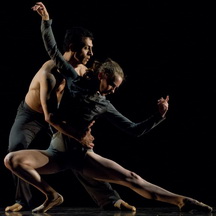Slow Dancing at the gym
Pascal Rioult’s company opened its Saturday evening performance at Cal Performances with a contemporary interpretation of the Nijinska–Stravinsky ballet, Les Noces. Meant to portray a peasant village wedding, the ballet early manifests that it is both sexual and political. The marriage, according to Nijinska, was “an act of immolation”—neither bride nor groom chose the other but was simply part of a ritualized drive for procreation. “No question of love entered into it. How can it be possible for two such creatures to feel rejoicing?”
Rioult’s ballet agrees with the sentiment. It is highly sexual, and the patterned intricacies of the dancers’ movements suggest disconnection rather than love and affection.
Two groups of four dancers, one female, the other male, dress for a wedding. There is a locker room quality to the scene: clothes are on the floor or hanging from a single rack, four metal folding chairs are parallel to the edge of the stage. The chairs, which the dancers perform around, over and with, are office brown with the undersides of the seats painted bright red, suggestive of hidden desire.
At one point the dancers align the chairs in two parallel lines perpendicular to the audience. Their backs to each other—women on one side, men on the other—they rock back and forth enacting lusty sexual urgings. It’s like the subtext to a high school dance at the gym—oozing hormones barely repressed.
Fast dancing on the planet
The second piece, choreographed to Ravel’s beautiful and madcap La Valse, looks another way, perhaps, at romantic love. Using the kinetic metaphor of the waltz—the couple’s dance of the Romantic era, based on the circle—six dancers in a tightly packed group rotate incessantly while revolving around the entire stage in a kind of gear-within-a-gear movement. A dancer drops to the ground, spun out by the frenetic motion of the group, picks himself up and runs to rejoin the swirl.
Now and then, the dancers break apart into cavorting couples scattered across the stage before reforming into a group. There is violence between them, a man head-butts his partner, once, twice. She falls. Another falls. The motions are percussive and ominous. The dancers’ heads are down, gaze pinned to the floor.
In one sequence, a light from the side flings soft shadows of the dancers onto the brownish gray-lit background. What metronome has run amok, casting off the shimmering lightness of love?
Ravel’s Bolero, the music for the third piece of the evening, brings order back to the dance. Rioult’s choreography follows the logic of the music. The company, clad in silvery gray leotards, form in two staggered lines. Following the rhythmic pulse of the music, the dancers step back and forth in sharp short movements that repeat and are synchronized.
For each woodwind solo that lofts above the ostinato, a soloist breaks out of the company patterns, performing a series of moves based on sustained and balanced gesture—long extensions, a slow promenade in attitude. As the music continues, more dancers perform their renegade solos, bringing the dance to its dramatic finale.
—Jaime Robles
Originally published in the Piedmont Post
